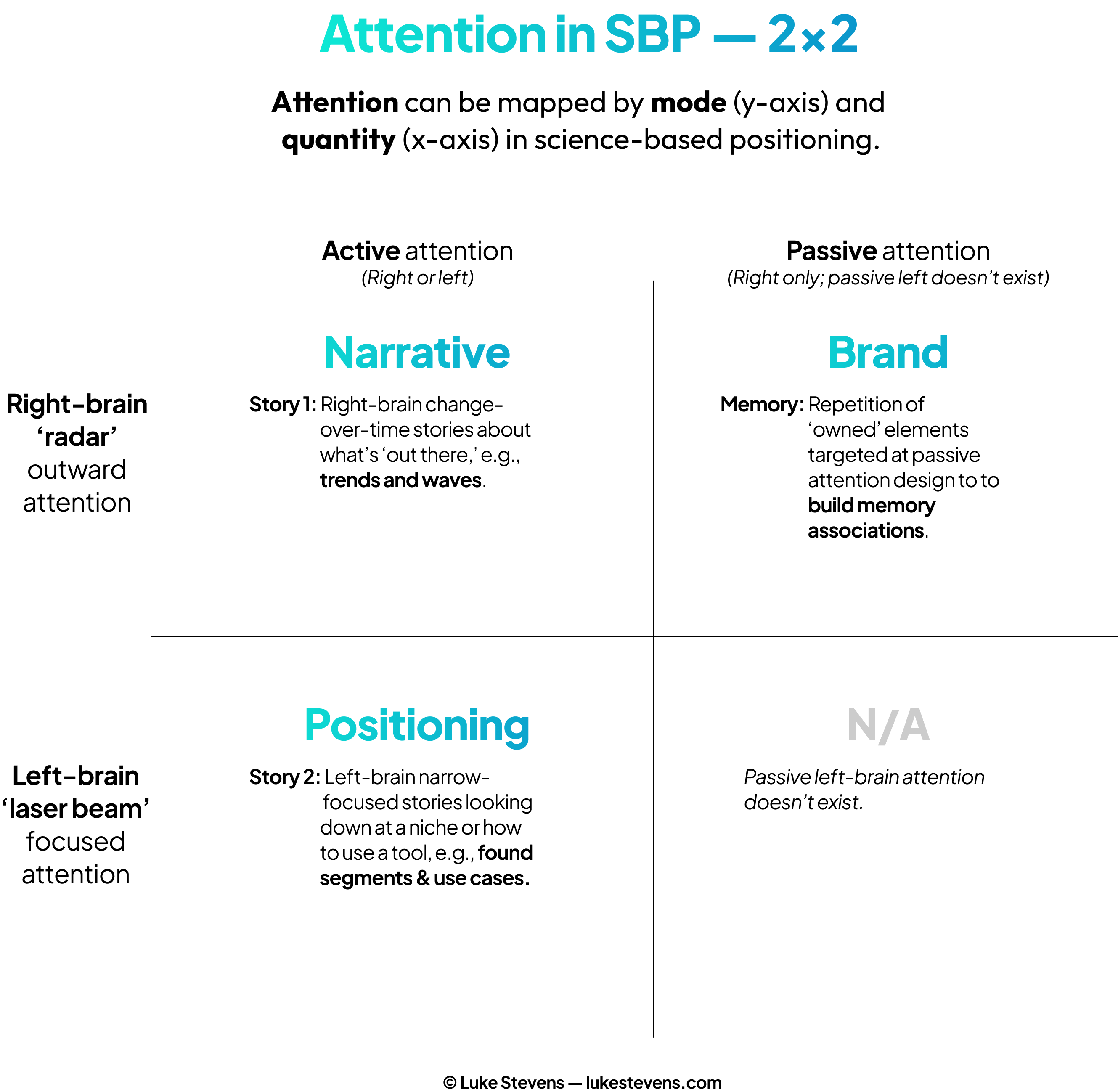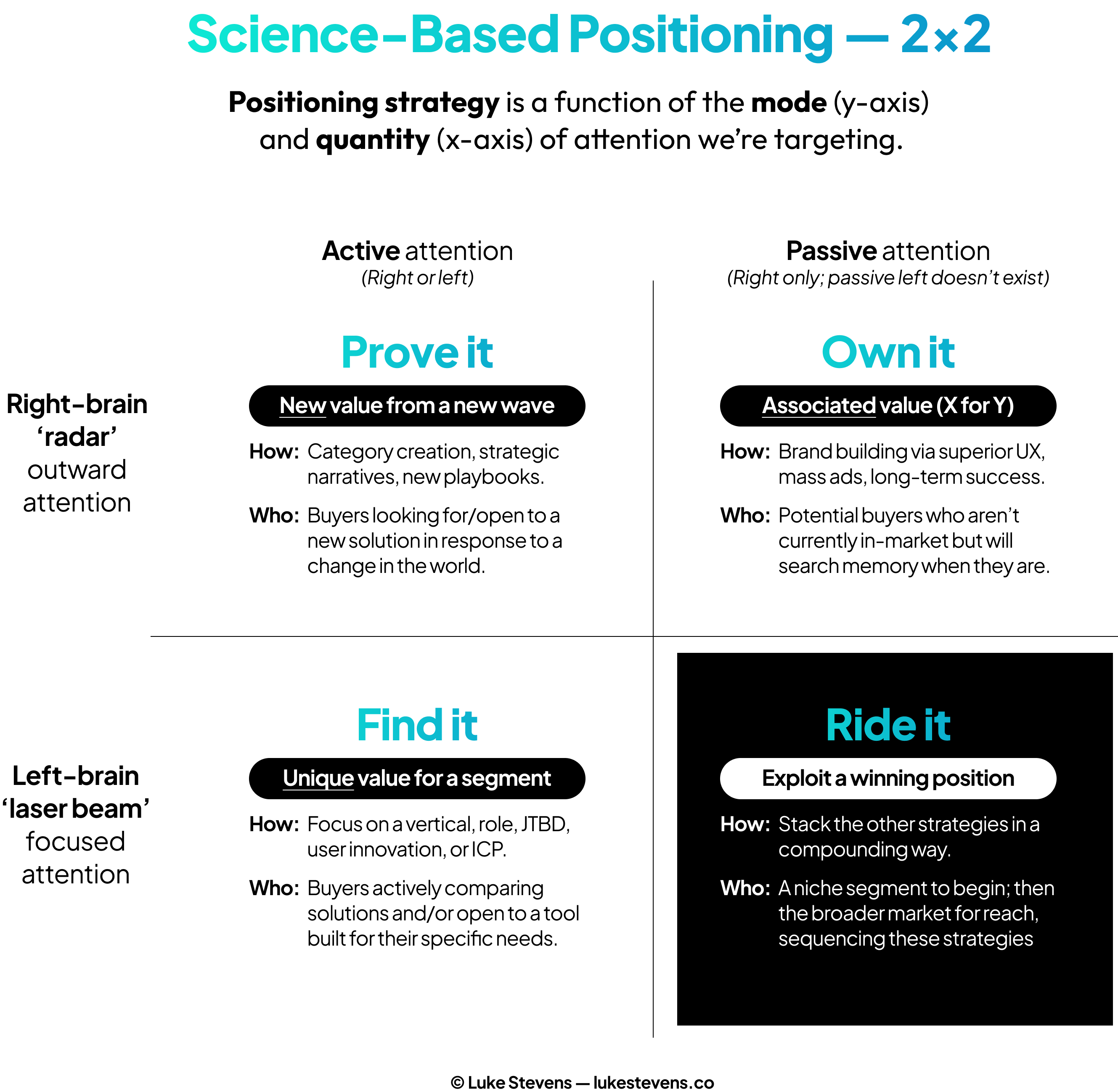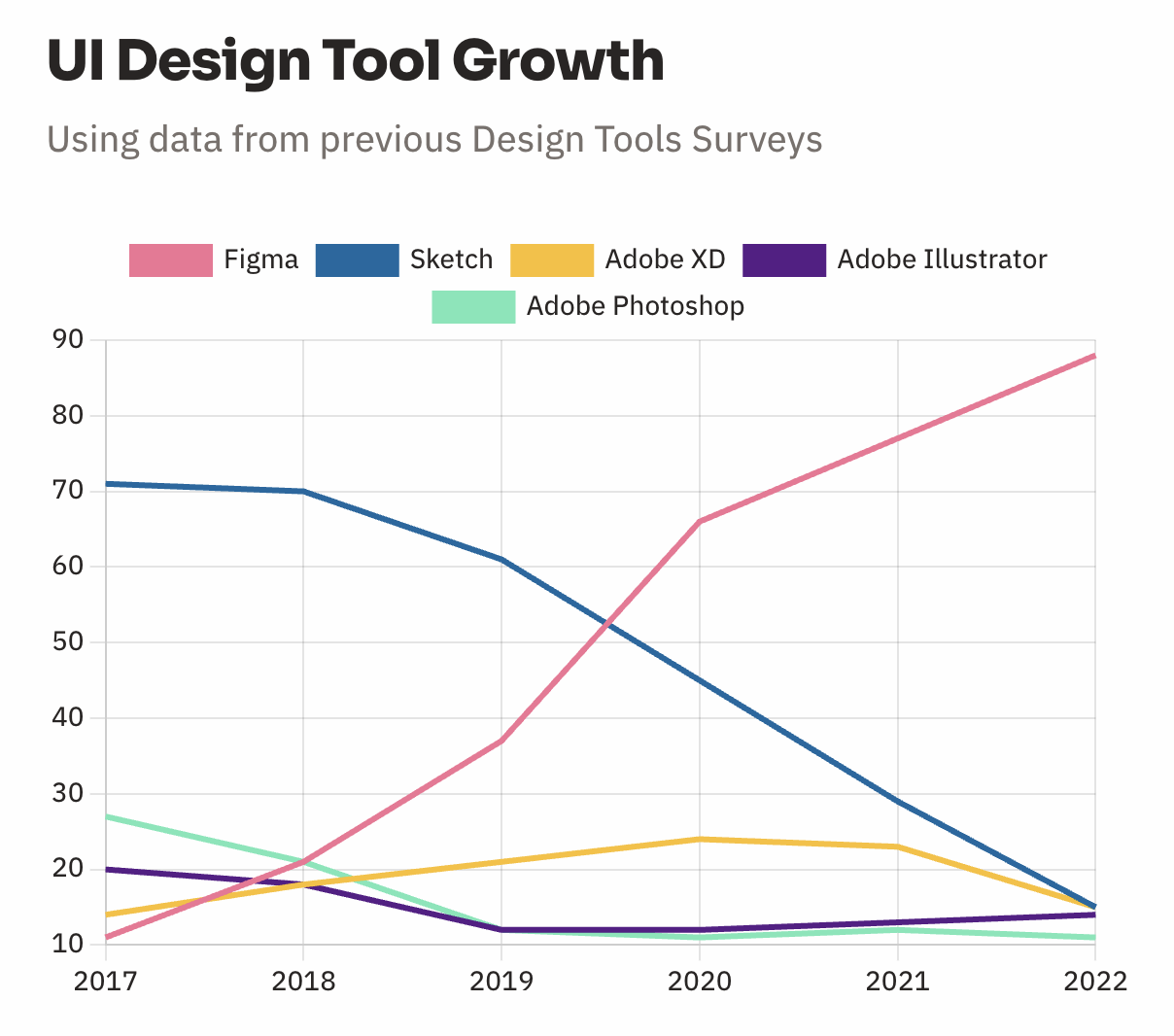Home → Founder Vision
The four positioning strategies
Summary: Prove it & ride a wave, find it & focus on a niche, own it & build a brand, & ride it when you’ve found a winning position.
In previous sections, we’ve looked at:
- One big idea: Positioning needs a science-based update, and there’s plenty of science to draw from.
- Two modes of attention: The fundamental breakthrough in scientific understanding for us folks in sales-led B2B is the hierarchy of attention and the two modes of attention we need to address.
- Three areas of science: Attention science for prospects, market science (diffusion and brand) for our go-to-market strategy, and N=1 experiments to run meaningful positioning experiments in the attempt to dominate a niche.
That’s all great, but what do we actually do with all this theory? How do we use it to make your vision as a founder stronger? In this section, I’ll walk you through how we go from these fundamentals to a framework with four simple positioning choices.
The point of these choices, or strategies, is to strengthen your vision so you know how to see and what to look for. I’ll give you a quick summary of each choice here along with an explanation of how we arrive at these choices. Then we’ll explore each in more depth with some of the canonical examples from the B2B SaaS world, ending each section with questions that relate to your vision and what you see in your market.
Let’s get into it.
Prove it, find it, own it, ride it
First, here’s a high-level summary of each positioning strategy and the action to take to achieve it.
- Wave riding — prove it: Picking a wave to ride is, in some ways, the easy part (“Let’s do an AI app!”), and sometimes people get lazy and just assume the narrative around the wave — and not their product — will do all the work. But you’ve got to prove it out — do the N=1 experiment, get down in the weeds, and objectively prove the new value that this wave supposedly offers.
- Niche positioning — find it: Finding a niche can either be a bet on a vertical, a particular attribute, a customer role, or a specific job-to-be-done where your product offers extraordinary value. But you’ve got to find it. This means customer research and market analysis to find unique value. Get out the laser beam — you’re going to need it.
- Brand building — own it: Most brand-building efforts falter because the CEO or founder doesn’t own it and doesn’t set a high bar for consistency and quality. Someone has to own it, and if you can maintain consistency and frequency, you can build associative value. (Just don’t make it someone’s job title, or things might get weird — looking at you, Chief Brand Officers.)
- Winning positioning — ride it: The point of all this is to develop a winning position where you dominate a segment and growth compounds such that you can ride that momentum to your next round of funding, growth milestone, or the next phase of your company.
Finding a winning position is the point, but in tech, winning positions don’t last forever. All that change, disruption, and frenetic pace of development gives you a chance to get into the market, but it also creates risks of falling out of the market, or at least out of a winning position, and that’s when it’s time to revisit the other three strategies.
They are your four choices in a nutshell.
Your turn
- What choices will you make and what action will you take?
- Will you ride a wave, pick a niche, and/or try to build a brand?
Modes of attention
Let’s recap a little and I’ll explain how we land on these specific types of positioning and the choices that follow.
When we looked at the three areas of science in science-based positioning, we saw that:
- The foundation of positioning-based science is attention science.
- That attention science is based on a new, modern theory of left-brain and right-brain attention called the hierarchy of attention and comes from Dr. Iain McGilchrist.
- Right-brain attention tends to be ‘radar’ attention that looks out at the world and change over time.
- Left-brain attention tends to be ’laser beam’ attention that’s focused down on the parts and pieces, using tools, and mapping things out.
Got i? This gives us our fundamental modes of attention.
But — and this is my spin on the theory — we can also think about the quantity of attention we pay to things in the world as well.
For example, in B2B tech sales, prospects are usually paying a lot of attention to what they’re buying. Their career might depend on getting the purchase and implementation right. It’s high-stakes!
But on the way home from work, they may grab some food, paying very little attention to their purchase, just going somewhere they recognize that’s on the way. The stakes are, shall we say, considerably lower.
Therefore, if we combine the mode and quantity of attention prospects use, we get this 2x2 of attention.
The Attention 2x2

This gives us three practical attention/technique matches, which are:
- Change-over-time narratives for active right-brain attention.
- Niche-focused positioning for active left-brain attention.
- Brand building for passive right-brain attention.
- There’s no fourth kind of attention because, for our purposes, passive left-brain attention isn’t really a thing.
This gives us “NPB” (narrative, positioning, brand) if you want a TLA. (I realize it’s a little weird to have ‘positioning’ as a subset of science-based positioning, but traditional positioning maps very closely to left-brain attention, so I’m sticking with it.)
These three approaches are how we connect with prospect attention, and this forms the basis of the choices we can make with our positioning.
This in turn gives us three of our four science-based positioning strategies (the fourth — ride it — being sticking with what’s working).
That is, when we think about how your company engages with prospects to enter a market, we can see that most companies are applying their own attention in one of three ways:
- Wave riders
- Problem finders
- Memory builders
If you can maximize or combine those strategies, you get a winning position. That’s the classic product/market fit pull where momentum compounds.
The SBP 2x2 (again)
Now, let’s layer on what you actually do to enact these strategies: prove it, find it, own it, or ride it (with apologies to Daft Punk).
This gives us the 2x2 we touched on when looking at our one big idea:

Making choices
Strategies are just choices, and you can, in theory, choose all three. Some of the best companies really do combine a strong change narrative with a laser focus on their tool, building an incredible brand in the process. These choices are not mutually exclusive. If you can stack all three, you’re golden.
Figma, for example (as I discuss at greater length in Positioning Playbook) did this really well. They managed to:
- Prove it: They rode the wave of the rise of digital product teams and design systems, studying how modern product teams work so they could prove their value.
- Find it: They had incredible laser focus on their product and technology, zeroing in on the appropriate use case for their WebGL-powered tech, which competitors simply couldn’t copy.
- Own it: They owned their brand and wrapped all of this up in distinctive, memorable, and consistent marketing assets. Plus, the collaborative, multiplayer nature of the tool often drew in the entire org, exposing everyone to the brand and Figma experience.
- Ride it: They found a winning position, one that ultimately had Adobe licking their lips in anticipation of acquiring them for $20B. While that wasn’t to be, Figma’s complete dominance of their category absolutely was, as the chart below from UX tools demonstrates.

All of this is to say that your brand, your change story and the wave you ride, and/or your ability to drill right down to the nuts and bolts to solve your users’ problems can deliver extraordinary results when these actions compound.
New vocabulary
The real utility here is having the framework and vocabulary to tease these things out. It’s not enough to say, “We need to build the brand,” or “We need to focus on a problem,” or even “We need to ride the current wave.” Fundamentally, all these things need to connect in a coherent way so you can meet the market’s attention in a coherent way.
That’s easier said than done, of course, so rather than trying to do it all at once, we’ll break things down into individual strategies, with a bunch of examples for each, so you can see how they work and the choices you have available to you.
Your turn
- Go back over the four main strategies — where does your startup or company fit?
- What strategy (or combination) did you use to get your current position?
- What approach has the most untapped potential for you in the future?
Compounding fundamentals
Again, science-based positioning isn’t a case of just catching a wave, or just finding a niche, or just building a brand. There’s always a bit of each going on. What’s interesting, though, is the fundamentals of attention at play:
- You can hit folks on their right-brain radar by catching a wave.
- You can meet them down in a niche with left-brain focus.
- And/or you can build a brand with passive right-brain attention over the long term.
These are the new fundamentals we have to work with.
The question is, which approach can you be great at? Which approach clarifies what you’re doing, makes sense of your own attention preferences, and gives you the best shot at reaching a meaningful exit in your market?
Next, we’ll explore these four strategies, with examples.
First published: · Last updated: